Tickets
A ticket is an overview of activities connected in one thread. The ticket can include email, calls, SMS, or any other available activity.
Ticket Views
Open the Ticket module in the main menu.
Views
Select a view from the list between the main menu and the tickets. A view works like a predefined filter that helps you see relevant tickets. Views are set up by your administrator or team leader. To set up your own filters, see Filtering.

Filtering
To set up your own filter, click the Filter button at the top left of the ticket list in any view.
The Search window will open. Define your filter and click Search at the bottom of the window to apply the filter. You can save your filter using Filter schemes.
Filter Schemes
You can save a filter to use it again in the future using Filter schemes. Define your filter and click Save as.
Type your Scheme title and click Save.
Click Search at the bottom of the window to apply the filter.
You can quickly access your saved Filter scheme in any view using the dropdown menu next to the Filter button.
Click the scheme title to apply it to the current view.
Ticket List
Each view displays a list of tickets that match its criteria. The top of the list contains bulk controls.

Filter tickets. Use the drop down menu to select a saved filter scheme.
Filter only your favourite tickets.
Filter only your tickets.
Clear filter and selection.
Bulk change selected tickets (1 or more tickets need to be selected).
Merge selected tickets (2 or more tickets need to be selected).
Delete selected tickets (1 or more tickets need to be selected).
Create a new ticket. See Ticket details.
Anonymise ticket including activities.
Export the list of tickets in the view.
The list of tickets is below the controls. Sort the tickets by individual columns by clicking the column name.
A new ticket or a ticket with a change will be bold (unread) until its owner opens it.

Bulk select tickets.
Open ticket.
Open the Contact or Account in the CRM module.
Customer journey – see the contact's history.
Ticket stage. Closed tickets with this symbol have a re-open date and time set.
Ticket summarise. Open a window with ticket summary.
Take ownership of the ticket – only active if the ticket has no owner.
Delete the ticket. After you click Delete, choose whether to simply delete the ticket or to also anonymise all related activities and all data is now anonymised including comments to the ticket. Anonymised tickets are no longer deleted – they remain in your helpdesk but don’t contain any personal information. Use anonymising with caution!
Ticket Details
As the owner of a ticket, any unread activities will be highlighted when you open it, with the count displayed at the top.

This ensures you don't miss any new activities, even if there are several.
The top part of the ticket detail screen contains general ticket controls.

Hover over to display the ticket's parent and/or child tickets. Click to open the ticket's list of parent and/or child tickets in the Tickets tab – see 4 in the bottom part below.
Follow ticket. Your user name will appear in the Followers field (see 11 in middle part of ticket details below).
Call from ticket.
Email from ticket.
SMS from ticket.
Chat from ticket.
Display ticket change history.
Go back to the list of tickets.
Save ticket.
Open list of macro options (see 10 in bottom part of ticket details below).
Open the Ticket Summarisation.
The middle part of the ticket detail screen contains important ticket parameters.

Click the magnifying glass and search for the ticket's primary contact.
If you select a Contact that is part of a CRM Account with an SLA set up, its SLA will be used instead of the Category's one.
Type the ticket title.
Select a category. The ticket's category sets its SLA unless a Contact that is part of a CRM Account with a different SLA is selected in 1. above. (If you have a category description set, you can view it by hovering over the tooltip.)
Select a deadline manually (set by your SLA and priority if left empty).
Select a priority.
Select a date to reopen the ticket if stage set to Waiting or Closed.
Select a status. If the category you have chosen has a mandatory status, you must select a status when you close the ticket – you can leave it empty until then.
Type a description.
Select the ticket owner. You can take ownership yourself or pass the ticket on to someone else.
Select a stage:
Open – the ticket is being handled.
Waiting – a reply has been sent to the customer, waiting for their reaction. You can set a reopen date (6).
Closed – the ticket has been solved. You can set a reopen date (6). If the customer replies, the ticket will be set to Open again.
Archived – the ticket has been solved. If the customer replies, a new ticket will be created automatically.
Enter ticket followers. They will receive notifications when there are any changes to the ticket.
If a change is made while you are in the ticket, you will receive a notification indicating which agent made the change. If the change is made by data, the notification will show that the change was made by the system.
If you have a custom form set up for your tickets, you will find it below this part. Ask your Team Leader or Supervisor if you are unsure how to fill it out.
The bottom part of the ticket detail screen contains additional info and controls.

Add a comment to the ticket.
View and add CRM records.
View ticket attachments.
View previous tickets.
In the Actions column, you can merge them with the current ticket by clicking the button Merge.
Add them as a child or parent ticket by clicking the button Link as.
Remove their child/parent relationship by clicking the button Unlink
View past activities.
View articles.
Open the dropdown menu with AI Actions. See more information here.
Go back to the list of tickets.
Save the ticket.
Custom macros – your team leader or administrator may set up different ones.
Select a file to attach to the ticket or drag and drop files into the grey area around the Select files button.
The ticket activity history is located below.

Expand/collapse all activities in the ticket.
Filter specific activity types. Open more activity types using the dropdown list.
Refresh the activity list.
Expand single entry.
Mark as important and activity controls. You can:
Call and text from activities with a phone number.
Send an email (reply or forward) from activities with an email address.
Send messages from activitites with a Facebook/WhatsApp/Viber contact.
Add a Comment. A summary of the activity you are commenting on will be added to your comment.
Open the activity detail.
Using the dropdown menu, you can Create a child ticket, Print the activity, Create an article from comments and emails, Create a template from emails, Remove from ticket, Move to another ticket.
Translate a comment.
Jump to the next activity in the list.
Hover over phone number and email links to bring up a list of actions:
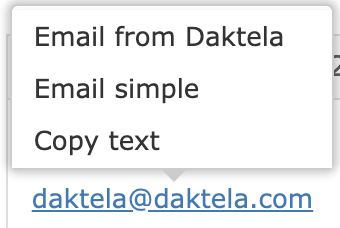
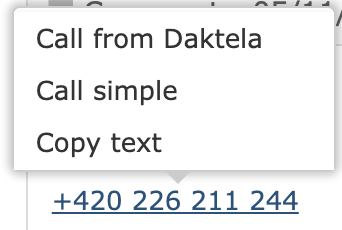
GPT Integration
Ticket Summary
The Ticket Summary is a feature that allows you to generate an overview of activities associated with the ticket and simultaneously creates a list of tasks by clicking a single button.
You can open the summary from the list of the tickets by clicking the Summarise button:

Directly in the ticket details:

The Ticket Summary window opens.
The window is divided into two parts: the first provides an overview of ticket activities, while the second displays tasks related to the given ticket.
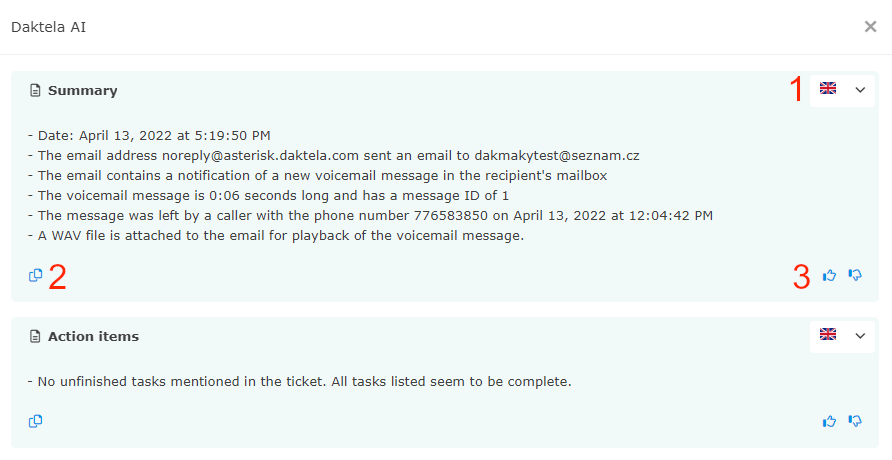
Change language. The results will be displayed in the language you have set for your Daktela account. If you wish to change the language, click on the flag button and select your preferred language.
Copy the summary text.
You can use the thumbs to provide feedback on whether you are satisfied with the result or not.
Compose Features
The Compose Features is a tool that makes it easier for you to write texts in the Daktela. With its help, you can edit your text and shape it exactly according to your needs.
Compose features are available in all large text inputs: emails, chats, comments and knowledge base articles.
You can edit the text by clicking the AI function button.

A drop-down menu with AI functions will open.
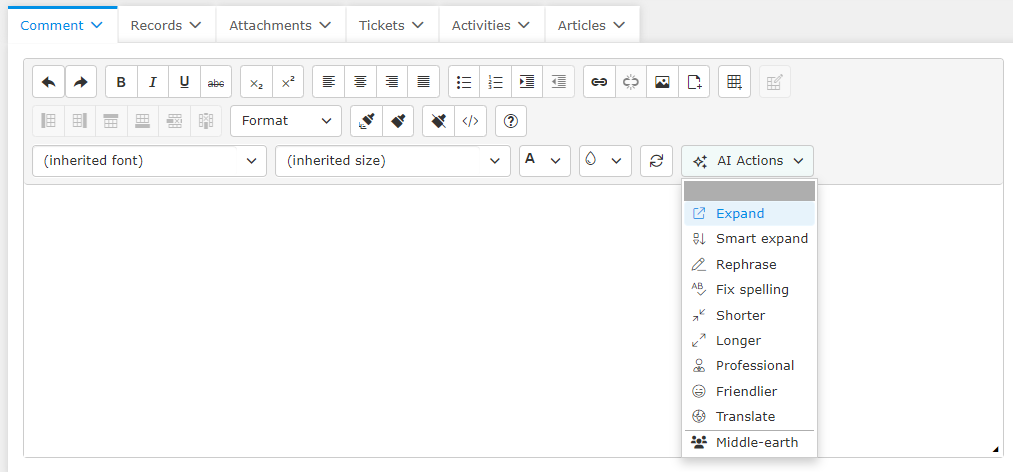
When you select any item from the dropdown menu the Daktela AI window will open, where the result will be generated.
You can have a custom GPT action tailored to your specific needs and preferences directly on your domain. You can find it at the bottom of the drop-down menu. Ask your supervisor to add it in your Accesses.
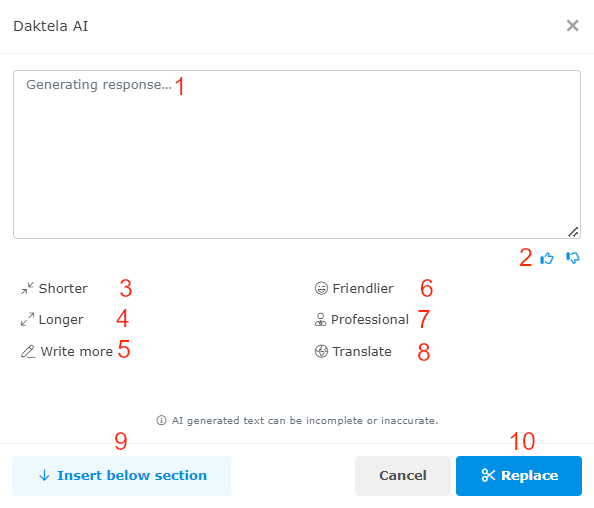
A text area available to generate your chosen text.
Use the thumbs to provide feedback on whether you are satisfied with the result or not.
Make your text shorter.
Make your text longer.
Keep the original text and adds an extension to it.
Transform the text into a friendlier tone
Transform the text to professional wording.
Translate the text into the language of your choice.
Insert text below the selected section..
Replace the selected text.
